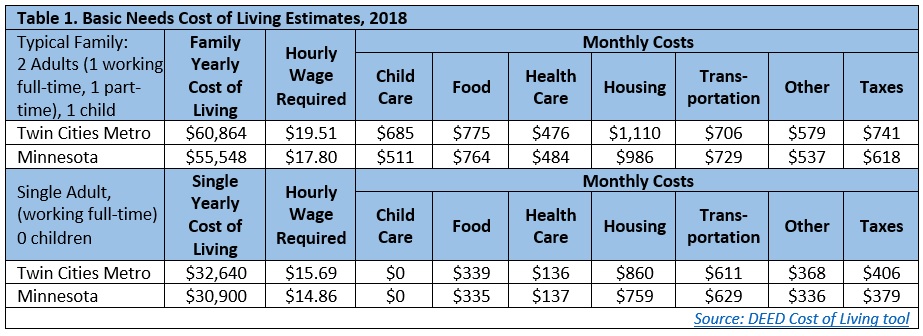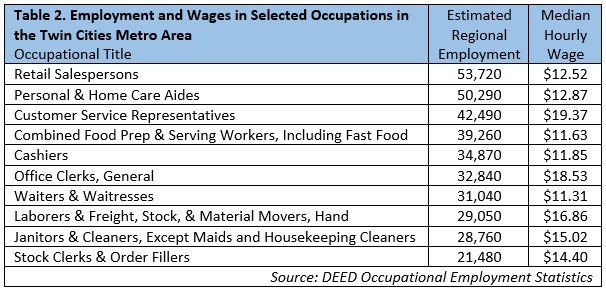 The Minneapolis-St. Paul metropolitan area is a national leader in finance, advanced manufacturing, agriculture and retailing.
The Minneapolis-St. Paul metropolitan area is a national leader in finance, advanced manufacturing, agriculture and retailing.
Medical devices, electronics and processed foods are strong suits recognized globally.
Want the freshest data delivered by email? Subscribe to our regional newsletters.
8/9/2019 3:00:00 PM
Tim O'Neill
Ever wonder what it takes to meet a basic needs cost-of-living in the Twin Cities Metro Area? You’re in luck: According to data from DEED’s Cost of Living Calculator, a single individual without children would need to earn an hourly wage of $15.69 (equivalent to an annual budget of $32,640) to meet this threshold. For the typical family of three, which includes one full-time working adult, one part-time working adult, and one child, each working adult would need to earn an hourly wage of $19.51 (equivalent to an annual family budget of $60,864) to meet basic needs in the region.
What is included in “basic needs”? DEED’s Cost of Living Calculator was designed to measure a simple living that meets basic needs for health and safety. There is no money built in for savings, vacations, entertainment, eating out, tobacco, or alcohol, even though some of these may be considered part of a normal healthy life. Beyond detailing the hourly wage and yearly budget individuals and families would need to meet basic needs in Minnesota, its regions, and its counties, the Cost of Living Calculator also breaks down monthly costs by category. These categories include child care, food, health care, housing, transportation, other necessities, and taxes (Table 1).

According to DEED’s Occupational Employment Statistics (OES) data, the median hourly wage in the Twin Cities was $22.78 in 2019. This certainly meets the basic needs budget for both individuals and families in the region. Zooming out, however, the middle 50 percent of jobs in the region earn between $14.88 per hour and $35.80 per hour, and 25 percent of workers earn less than $14.88 per hour. Clearly, not all jobs result in wages which meet the basic-needs budget for the area.
Along with health care practitioners – such as surgeons, doctors, dentists, psychiatrists, and other specialists – occupations with the highest median wages are typically found in management, computer and mathematical, architecture and engineering, and legal occupational groups. These, of course, are occupations which require extensive levels of post-secondary education and training.
At the other end of the spectrum, occupations with the lowest median wages are typically found in food preparation and serving related, personal care and service, farming, building and grounds cleaning and maintenance, sales, and health care support occupational groups. Occupations within these groups typically do not require post-secondary education. Also, these six occupational groups account for over 508,000 jobs in the Twin Cities, or over one-in-four jobs. These occupations are vitally important to the region’s economy (Table 2).

Contact Tim O’Neill at 651-259-7401.